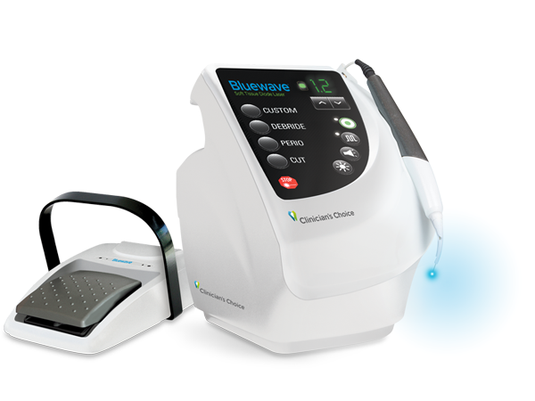
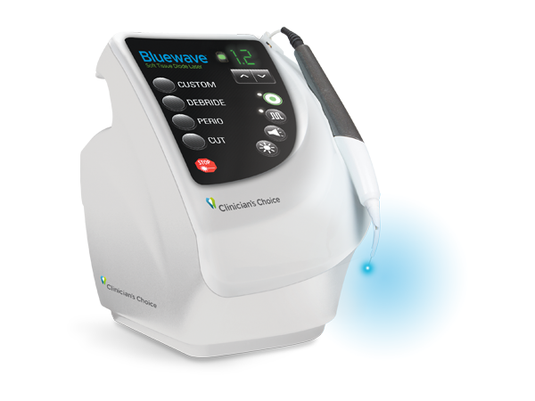
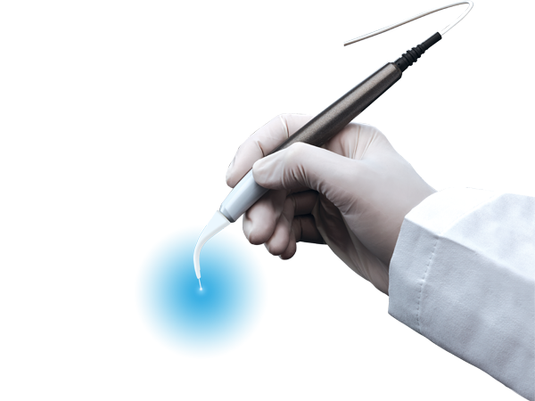
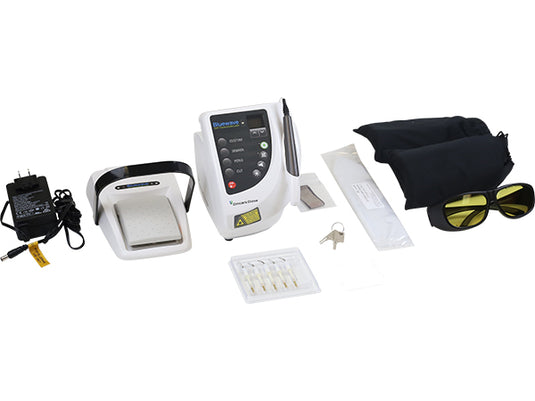
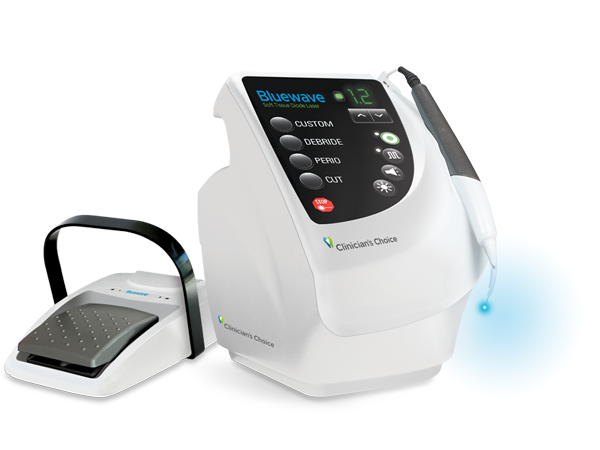
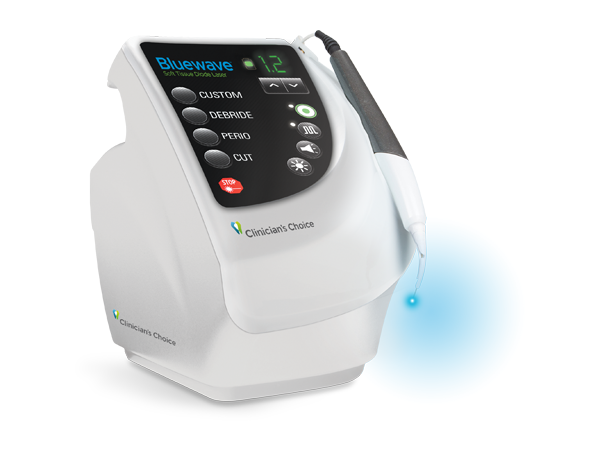
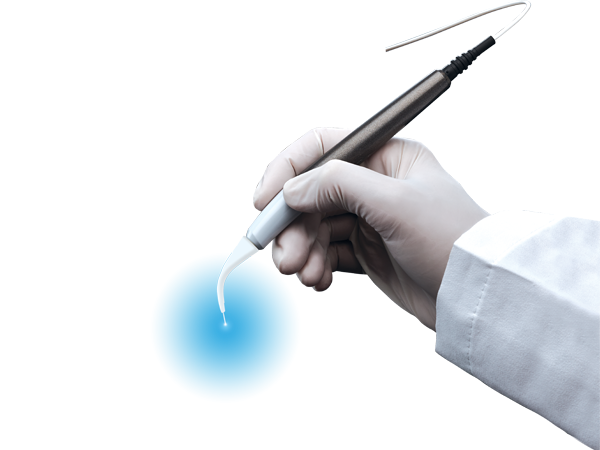
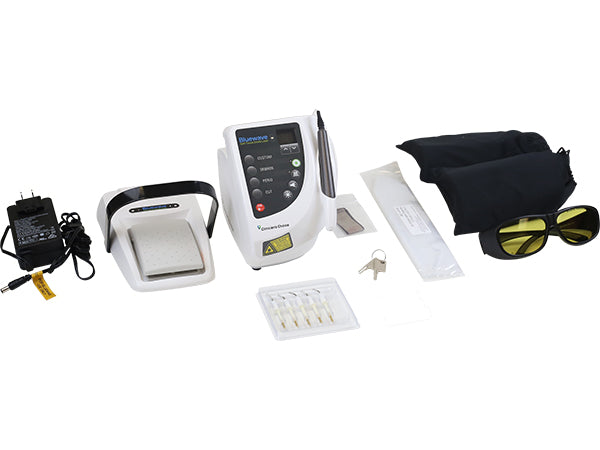
- Product Details
- Clinical Technique
- Technical Details
- Video
- Configurations
- FAQ
- Resources
- Accessories
The Bluewave™️ Soft Tissue Diode Laser lets you perform many soft tissue procedures with virtually no bleeding, pain, post-operative swelling or discomfort. This powerful 5W laser is completely portable, allowing for over three hours of use on its rechargeable lithium-ion battery. Ideal as a surgical instrument or for non-invasive laser-assisted periodontal and hygiene therapy – the Bluewave is a versatile and intuitive instrument for your every need.
Other features and benefits include:
- Lightweight, portable 5W 810nm soft tissue laser.
- Three pre-programmed settings (debride, perio, and cut) and one custom setting.
- Rechargeable lithium-ion battery provides three hours of continuous use at maximum capacity on every charge.
- Unique blue-aiming beam, providing greater visibility in intraoral tissues and blood than the traditional red beam.
- Two sizes of disposable tips (4mm and 9.5mm) are easily placed and removed without the need to cleave fiber.
Indications for Use:
- Laser troughing
- Class V restorations
- Gingivectomy
- Hyperplasia
- Esthetic recontouring
- Frenectomy
- Implant recovery
- Destruction of lesions
Gingivectomy
Power: 1.0 watts | Mode: Continuous | Tip: Initiated

Removal of hyperplastic tissue can be done quickly and effectively without the use of sutures or scalpels. Final impressions for restorations can be completed in the same appointment, leading to predictable results with no additional patient discomfort.
Laser Troughing
Power: 1.0 watts | Mode: Continuous | Tip: Initiated

By using the Bluewave diode laser, practitioners are able to obtain bloodless impressions with clearly exposed margins within seconds, eliminating the need to pack cord. Lasing improves visualization of prepared crown margins and aids in hemostasis, resulting in a more accurate impression.
Esthetic Recontouring
Power: 1.0 watts | Mode: Continuous | Tip: Initiated

Remove excess gingival tissue easily with the use of a diode laser. Common gingival esthetic problems such as excessive gingival display or asymmetrical contours are corrected quickly and painlessly with minimal healing time.


Introducing the Bluewave Soft Tissue Diode Laser
Dr. Doug Harvey talks about some of the features and uses of the Bluewave Soft Tissue Diode Laser.
Set up instructions for the Bluewave Soft Tissue Diode Laser
Incisional Biopsy using Bluewave Soft Tissue Diode Laser
Bluewave Soft Tissue Diode Laser (Item Number: 444000) comes as an individual unit. Package includes:
- Bluewave desktop laser unit
- Power supply
- Wireless foot pedal
- 3 x AA batteries for the foot pedal
- 25 x Single-use diode laser sleeves for handpiece
- 5 x 4mm disposable tips
- 3 x Safety glasses
- Initiating film
- User manual
- FREE online training course
Q: How will the Bluewave laser benefit my practice?
A: Diode lasers offer the most control over the soft tissue operative site with their ability to ensure precise tissue sculpting simultaneously cutting and sealing the tissue, resulting in immediate hemostasis and more rapid healing compared to traditional surgical methods. This will allow the clinician to move the patient directly from a hygiene procedure to a same-day restorative case with no wait time. Unlike electrosurgery, the diode laser can be used next to metal crowns and implants, expanding your scope of soft tissue surgeries. The introduction of a laser also creates the opportunity for the clinician to perform soft tissue procedures that often may be referred out.
Q: What financial benefits does the Bluewave diode laser offer?
A: The Bluewave diode laser can produce incremental practice revenue through additional procedures that may be commonly referred out. Esthetic gingival recontouring, post-orthodontic gingival hyperplasia and laser-assisted periodontal treatment are examples of procedures that can be kept in-house. The rapid healing associated with lasers also increases patient acceptance, as patients are more likely to accept when second or third appointments are not required and post-operative recovery is significantly reduced.
Q: How do diode lasers work?
A: Diode lasers emit energy that is absorbed by the soft tissue causing it to vaporize. This occurs in a precise, controlled fashion with little to no bleeding or swelling, and significantly less post-surgical pain.
Q: What are the benefits for the patient?
A: Diode lasers allow for precise soft tissue surgeries with little to no bleeding. Laser surgery is substantially less invasive and more predictable than conventional surgical techniques using a scalpel or electrosurgery. In some cases, laser surgery can be performed with minimal need for anesthesia. Patients can expect far less post-operative discomfort and swelling with more rapid healing. The effects of the surgeries are almost immediately appreciated.
Q: How is the Bluewave diode laser different from others?
A: The Bluewave laser is one of the most competitively priced diode lasers on the market today. The Bluewave laser operates in the 810nm wavelength where it has a higher affinity for hemoglobin and melanin than it does to water. This makes it ideal for intraoral soft tissue procedures. It is also the only diode laser to feature a blue guiding beam, which increases surgical accuracy through its contrast with oral tissues and blood.
Q: Is there training/certification required to use the Bluewave laser?
A: Certification for dental laser use is regulated at the state level for dentists and hygienists and can frequently change. We recommend consulting with state laws when determining your training and certification requirements.
Q: What procedures can be performed with a laser?
A: The following is a list of FDA-cleared indications for use of diode soft tissue lasers:
- Excisional and incisional biopsies
- Exposure of unerupted teeth
- Frenectomy
- Frenotomy
- Gingival troughing for crown impression
- Gingivectomy
- Gingivoplasty
- Gingival incision and excision
- Hemostasis and coagulation
- Implant recovery
- Abscess incision and drainage
- Laser removal of diseased, infected, inflamed, and necrosed soft tissue within the periodontal pocket
- Laser soft tissue curettage
- Leukoplakia
- Operculectomy
- Oral papillectomies
- Pulpotomy
- Pulpotomy as an adjunct to root canal therapy
- Reduction of gingival hypertrophy
- Soft tissue crown lengthening
- Sulcular debridement (removal of diseased, infected, inflamed, and necrosed soft tissue in the periodontal pocket to improve clinical indices including gingival index, gingival bleeding index, probe depth, attachment loss, and tooth mobility)
- Treatment of canker sores, herpetic, and aphthous ulcers of the oral mucosa
- Vestibuloplasty
Q: What training resources are available?
A: CE training is provided at no charge with your purchase of a Bluewave Soft Tissue Diode Laser. CE credits will be available for confirmed completion. Visit ccl.gloheducation.com for more information.
Q: Can a hygienist use a soft tissue laser?
A: Depending on the state certification and training requirements, a hygienist may use a laser with a non-initiated tip for Laser Bacterial Reduction (LBR), bio-stimulation, and desensitization.
Q: How affordable is a laser?
A: The Bluewave Soft Tissue Diode Laser is economically priced. Its low price, portability and versatility make it the ideal laser for the whole office.
Q: How can my practice benefit from a laser?
A: General Practitioners: The general practitioner’s office can benefit from the Bluewave laser for restorative dentistry as well as hygiene:
- Soft tissue management for cosmetic and impression purposes with crown and bridge or implants
- Controlling bleeding for an ideal bonding environment
- Performing any soft tissue procedures normally referred out of the office
- The portable Bluewave laser is efficiently integrated into the restorative regimen. On the hygiene side, the Bluewave can be incorporated into periodontal therapy along with scaling and root planning.
Pedodontists: The Bluewave diode laser can enable any soft tissue procedure to be performed in a gentler, less invasive manner with much less post-operative discomfort for the pediatric patient. Typical procedures may include frenectomies, removal of gingival hyperplasias, incision and drainage of abscesses, and pulpotomies.
Periodontists: The Bluewave can be used for implant healing cap retrieval, cosmetic gingival recontouring, LANAP and LAPT (Laser Bacterial Debridement and Laser Curettage), procedures, gingivectomies and removal of hypertrophic gingival tissue.
Endodontists: Lasers have been used for years in root canal treatment. Diode lasers in the near-light wave lengths of 800-1000nm can be useful in root decontamination during the cleansing and shaping phase.
Orthodontists: The Bluewave laser can benefit orthodontists in the following ways: gingivectomy and/or removal of hyperplastic gingiva and bleeding for optimal placement of brackets; frenectomies to improve treatment outcome.
Q: Is the Bluewave laser portable/lightweight?
A: At 2.6 lbs and with a built-in handle, the compact Bluewave laser is easily transported between operatories. The rechargeable battery provides enough power for three hours of continuous high output, meaning that Bluewave’s versatility may be shared amongst operators before it has to be recharged.
View the Bluewave Settings Chart.
View the Bluewave Resource Book.
View the Bluewave Product Sheet.
View the Bluewave FAQ.
View the Bluewave IFU.
View article Utilizing a soft tissue diode laser for a direct resin restoration article by Dr. Troy Schmedding, DDS, AAACD.
View the Gingival Sculpting With a Soft Tissue Diode Laser featuring Susan McMahon DMD, AAACD, AGD.
View article Choosing a Laser: What Features Should You Consider?
View article Light the Way to Better Outcomes with an Innovative Soft Tissue Diode Laser in Dental Product Shopper.
View on-demand free course Teach Me to Be a Laser Dentist - A Crash Course on Diode Lasers and Restorative Dentistry by Dr. Ron Kaminer (1 CEU).
Bluewave Soft Tissue diode laser accessories include disposable tips, laser sleeves, safety glasses, foot pedal, power cord, optic cable, replacement keys, and a warning sign.
